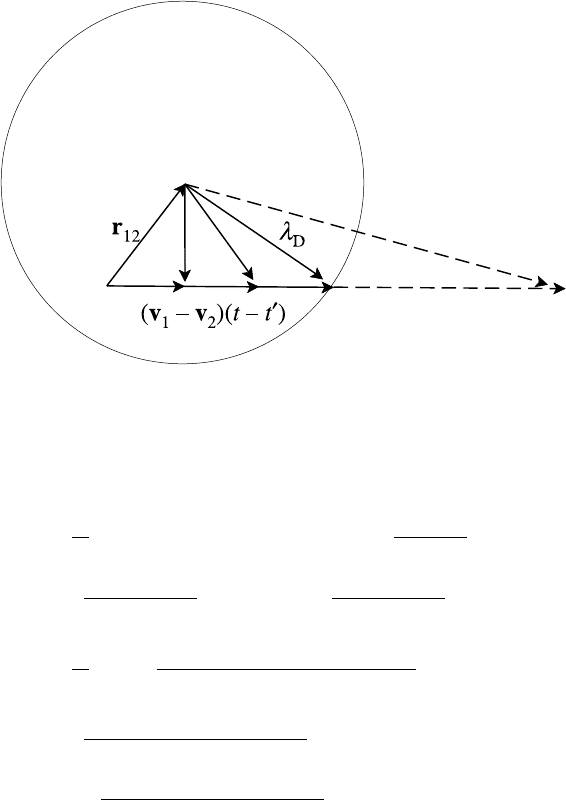Boyd T.J.M., Sanderson J.J. The Physics of Plasmas
Подождите немного. Документ загружается.


12.4 The Landau equation 477
Fig. 12.1. Time variation of |r
12
− (v
1
− v
2
)(t − t
)|; φ
s
≈ 0 unless both r
12
and |r
12
−
(v
1
− v
2
)(t − t
)| lie within a Debye sphere.
Then
g =
1
m
dt
dr
1
dr
2
G(r
1
, r
1
, r
2
, r
2
, t, t
)
∂φ
s
(r
12
)
∂r
1
·
∂ f (r
1
, v
1
, t
)
∂v
1
f (r
2
, v
2
, t
) −
∂ f (r
2
, v
2
, t
)
∂v
2
f (r
1
, v
1
, t
)
=
1
m
t
0
dt
∂φ
s
(|r
12
− (v
1
− v
2
)(t − t
)|)
∂r
12
·
∂ f (r
1
− v
1
(t − t
), v
1
, t
)
∂v
1
f (r
2
− v
2
(t − t
), v
2
, t
)
−
∂ f (r
2
− v
2
(t − t
), v
2
, t
)
∂v
2
f (r
1
− v
1
(t − t
), v
1
, t
)
(12.45)
Substitution of this expression for g in (12.24) (with φ replaced by φ
s
) does not
immediately yield a tractable kinetic equation because of the arguments of f in
the collision term. Indeed, one might say that it does not yet amount to a kinetic
equation at all because g is not expressed as a functional (as opposed to a function)
of f . However, Bogolyubov’s hypothesis leads to a number of simplifications so
that g does become a functional of f making (12.23) a kinetic equation.
Note first that since the arguments of the shielded potentials in (12.24) and
(12.45) are r
12
and |r
12
− (v
1
− v
2
)(t − t
)| and φ
s
(r) ≈ 0 for r λ
D
it follows
that the time interval (t −t
) λ
D
/|v
1
−v
2
|∼ω
−1
p
; this is illustrated in Fig. 12.1.
Next, since we assume that f does not vary significantly on this time scale (ω
−1
p
)

478 The classical theory of plasmas
nor over distances of order λ
D
, the arguments of f in (12.45) may be reduced to
(r
1
, v
1
, t) and (r
2
, v
2
, t) in which r
1
≈ r
2
. Letting τ = t − t
we may now rewrite
(12.45) as
g(1, 2) =
1
m
f (2)
∂ f (1)
∂v
1
− f (1)
∂ f (2)
∂v
2
·
∞
0
∂φ
s
(|r
12
− (v
1
− v
2
)τ |)
∂r
12
dτ
(12.46)
where we have taken the limit t →∞in the integral, which is allowed because,
as already observed, the integrand vanishes for τ ω
−1
p
. This expression for g is
now a functional of f and substitution in (12.24) gives
∂ f
∂t
c
=
1
m
2
dr
2
dv
2
∂φ
s
(r
12
)
∂r
12
·
∂
∂v
1
∞
0
dτ
∂φ
s
(|r
12
− (v
1
− v
2
)τ |)
∂r
12
·
f (2)
∂ f (1)
∂v
1
− f (1)
∂ f (2)
∂v
2
(12.47)
Writing φ
s
(r) in terms of its Fourier transform
φ
s
(r) =
e
2
(2π)
3
ε
0
dk exp(ik · r)
k
2
+ k
2
D
where k
D
≡ λ
−1
D
, (12.47) becomes
∂ f
∂t
c
=−
e
4
(2π)
6
ε
2
0
m
2
dr
2
dv
2
dk dl
exp(ik ·r
12
)
(k
2
+ k
2
D
)
k ·
∂
∂v
1
∞
0
dτ
exp{il ·[r
12
− (v
1
− v
2
)τ ]}
(l
2
+ k
2
D
)
l ·
∂ f (1)
∂v
1
f (2) −
∂ f (2)
∂v
2
f (1)
(12.48)
To simplify this expression we integrate over r
2
space first. In doing this we use
a similar approximation to that for the time integration in (12.45) and assume
f varies on a length scale much greater than λ
D
; since the integrand in (12.48)
contains φ(r
12
) it vanishes exponentially for r
12
λ
D
so that we may replace r
2
by r
1
in f (2). The integration over r
2
then involves exp[−i(k + l) · r
2
] only and
gives (2π)
3
δ(k+l). The integration over l space is then trivial and (12.48) becomes
∂ f
∂t
c
=
e
4
(2π)
3
ε
2
0
m
2
dv
2
dk
(k
2
+ k
2
D
)
2
k ·
∂
∂v
1
∞
0
dτ exp[ik ·(v
1
− v
2
)τ ]k ·
∂ f (v
1
)
∂v
1
f (v
2
) −
∂ f (v
2
)
∂v
2
f (v
1
)
(12.49)

12.4 The Landau equation 479
The integration over τ is given by the Plemelj formula
∞
0
dτ exp[ik ·(v
1
− v
2
)τ ] = πδ[k ·(v
1
− v
2
)] − iP
1
k · (v
1
− v
2
)
(12.50)
where P stands for the principal part. However, the second term in (12.50) gives
no contribution to (12.49), since it makes the integrand odd in k (its contribution
must be zero since it is imaginary). Hence
∂ f
∂t
c
=
e
4
8π
2
ε
2
0
m
2
dv
2
dk
(k
2
+ k
2
D
)
2
k ·
∂
∂v
1
δ[k · (v
1
− v
2
)]
k ·
∂ f (v
1
)
∂v
1
f (v
2
) −
∂ f (v
2
)
∂v
2
f (v
1
)
(12.51)
Defining g = (v
1
− v
2
), this leaves an integration over k space of the form
k · Aδ(k · g)k · B
(k
2
+ k
2
D
)
2
dk (12.52)
which diverges at large k. This is a direct result of the weak coupling approximation
which clearly breaks down as r
12
→ 0, in fact for r
12
e
2
/4πε
0
k
B
T . We cut off
the integration therefore at k = 4πε
0
k
B
T/e
2
and find for (12.52)
π A
i
δ
ij
g
−
g
i
g
j
g
3
B
j
ln = π A
i
∂
2
g
∂v
i
∂v
j
B
j
ln (12.53)
where = 4πnλ
3
D
and only terms in ln have been retained.
Thus, using (12.21), the kinetic equation may finally be written
∂ f
∂t
+ v ·
∂ f
∂r
−
e
m
E ·
∂ f
∂v
=
e
4
ln
8πε
2
0
m
2
∂
∂v
i
dv
∂
2
|v − v
|
∂v
i
∂v
j
∂ f (v)
∂v
j
f (v
) −
∂ f (v
)
∂v
j
f (v)
(12.54)
where E is the self-consistent field given by (12.22). This form of the collision
integral for a plasma was first derived by Landau using an intuitive model for
collisions, so (12.54) is known as the Landau kinetic equation.
At this point it is of interest to consider the relationship of the Landau equation
to the Balescu–Lenard equation (12.28). A comparison of (12.28) with (12.51)
shows that the dielectric function (k, k · v
1
), has simply been replaced by the
term (1 +(k
D
/k)
2
), which is the static shielding factor introduced by replacing the
Coulomb potential φ by the shielded potential φ
s
. In fact the main effect of the
dielectric function is to produce shielding, but in the Balescu–Lenard equation it
appears as a dynamic effect involving the interaction of particles and Fourier wave
480 The classical theory of plasmas
components through the resonant integral in (12.30). Furthermore, it can be shown,
as for example in Nicolson (1983), that to the order of keeping only terms in ln
the Balescu–Lenard collision integral reduces to the Landau collision integral.
The generalization of the Landau collision integral to more than one species of
particle is given by (8.36). Since the latter equation was derived from the Fokker–
Planck equation this establishes an important link and justifies the applicability of
the Fokker–Planck model to a plasma.
12.5 Moment equations
In Section 7.2 we showed through Jeans’ theorem the formal equivalence of the
collisionless (Vlasov) kinetic theory and particle orbit theory. We turn now to the
relationship between collisional (Landau) kinetic theory and the MHD equations
discussed in Chapters 3–5. There is no simple theorem establishing this relation-
ship for there is not, even in a formal sense, an exact equivalence. The procedure
from microscopic kinetic description to macroscopic fluid description has rather
more in common with the derivation of the kinetic equation from the Liouville
equation. The reduction in detail of description, in this case the removal of depen-
dence on the velocity coordinate v, gives rise to an infinite chain of equations – the
moment equations. The derivation of the moment equations is the first of the three
basic steps that lead to the MHD equations. The second and most formidable is the
truncation and closure of the moment equations. This is where physical approxima-
tion enters and equivalence disappears; it is the subject of classical transport theory
discussed in Section 12.6. The final step is the derivation of the MHD equations
from the transport equations and the further physical approximations necessary for
this are examined in Section 12.7.
We begin with definitions of fluid variables in which we introduce the label α
(= i, e, for ions and electrons, respectively), to denote particle species. On scalars
α appears as a subscript but on vectors and tensors, for which we frequently need
to denote components by roman subscripts ( j, k, l etc.), it is more convenient to
write α as a superscript. Since f
α
(r, v, t)dr dv is the probability at time t of finding
particles of type α within a small volume element dr dv about the point (r, v)
the integral of this over all velocity space is the probability of finding particles,
irrespective of velocity, within a volume dr about r. Hence, the (number) density,
n
α
(r, t) is defined by
n
α
(r, t) =
dv f
α
(r, v, t) (12.55)
Similarly, the flow velocity u
α
(r, t) is the mean velocity of all particles of type α

12.5 Moment equations 481
in the volume dr about r at time t and so is given by
u
α
(r, t) =
dr
v f
α
(r, v, t)dv
dr
f
α
(r, v, t)dv
=
1
n
α
(r, t)
v f
α
(r, v, t)dv (12.56)
Other fluid variables like pressure, temperature and heat flux are defined in terms
of the random or thermal velocities of the particles
c
α
= v − u
α
(12.57)
Whilst the mean value of c
α
is clearly zero, the mean values of higher powers of
its components are non-zero in general and, for example, are related to the thermal
momentum flux and thermal energy flux and thereby to the pressure and heat flux.
Thus, we define the elements of the pressure tensor p
α
ij
(r, t) by
p
α
ij
(r, t) = m
α
c
α
i
c
α
j
f
α
(r, v, t)dv (12.58)
and the heat flux tensor q
α
ijk
(r, t) by
q
α
ijk
(r, t) = m
α
c
α
i
c
α
j
c
α
k
f
α
(r, v, t)dv (12.59)
It is convenient to separate p
α
ij
into two tensors by
p
α
ij
= p
α
δ
ij
+
α
ij
(12.60)
where
α
ij
= m
α
c
α
i
c
α
j
−
1
3
|c
α
|
2
δ
ij
f
α
dv (12.61)
is by definition a traceless tensor and
p
α
=
m
α
3
|c
α
|
2
f
α
dv (12.62)
is, for an isotropic plasma, the scalar pressure.
It is also useful to define a kinetic temperature T
α
(r, t) by extrapolating the well-
known result that for an ideal gas in equilibrium the thermal energy associated
with each degree of freedom of the gas is
1
2
k
B
T
α
. Since Boltzmann’s constant k
B
is always associated with T
α
we shall, in this chapter, absorb it into the definition
of T
α
(which is thereby measured in energy units instead of degrees). Thus, with
three degrees of freedom for each of the n
α
particles we have
3n
α
T
α
(r, t)
2
=
m
α
2
|c
α
|
2
f
α
(r, v, t)dv =
3
2
p
α
(12.63)

482 The classical theory of plasmas
Finally, the heat flux vector q
α
(r, t) is the flux of thermal energy relative to the
flow velocity and so is given by
q
α
(r, t) =
m
α
2
|c
α
|
2
c
α
f
α
(r, v, t)dv (12.64)
It then follows from (12.59) that
q
α
i
(r, t) =
1
2
q
α
ijj
(r, t) (12.65)
These velocity integrals by which the fluid variables are defined are called ‘mo-
ment integrals’ of f
α
. The order of a moment integral is given by the highest power
of the components of v occurring in the integrand. Thus, the density is a zero-order
moment, the flow velocity is a first-order moment, the pressure and temperature
are second-order moments and the heat flux is a third-order moment.
We now generate evolution equations for these macroscopic variables by taking
appropriate moments of the kinetic equation
∂ f
α
∂t
+ v ·
∂ f
α
∂r
+
e
α
m
α
(E + v × B) ·
∂ f
α
∂v
=
∂ f
α
∂t
c
(12.66)
Since r, v and t are independent variables it is clear from (12.55) that when we
integrate (12.66) over velocity space (i.e. take the zero-order moment) the first
term in the new equation is ∂n
α
/∂t so that this may be regarded as an equation for
the time evolution of n
α
(r, t). It is also evident from (12.56) that the second term
gives rise to ∇ · (n
α
u
α
), that is, the evolution equation for the zero-order moment
n
α
contains a term involving the first-order moment u
α
. We obtain an evolution
equation for u
α
by taking the first-order moment of (12.66), that is we multiply by
v and then integrate over velocity space. Now the leading term is ∂(n
α
u
α
)/∂t but
the second term again gives rise to a higher moment,
vv f
α
dv, which by (12.58)
is somehow related to the pressure tensor as well as to n
α
and u
α
. Clearly, this
drawing down of higher moments persists no matter how many moments of the ki-
netic equation we take. We have removed a variable (v) of infinite dimension but, in
doing so, have generated an infinite chain of moment equations. Such mathematical
transformations do not reduce the basic complexity of the description. To achieve
this we need approximations based on physical assumptions. Up to this point we
have merely outlined a scheme for replacing one equation in seven-dimensional
space (r, v, t) by an infinite set of equations in four-dimensional space (r, t) and
there is, thus far, an exact equivalence between these descriptions. For the present,
we shall not worry about how the real simplification is to be achieved but will go
ahead and generate the first few equations in the chain.

12.5 Moment equations 483
It is useful to obtain a general moment equation by multiplying (12.66) by ψ(v),
where ψ(v) is any polynomial function of the components of v, and integrating
over velocity space. Defining
ψ=
ψ(v) f
α
dv
f
α
dv
=
1
n
α
(r, t)
ψ(v) f
α
(r, v, t) dv (12.67)
we get
∂
∂t
(n
α
ψ) +
∂
∂r
· (n
α
vψ)
−
n
α
e
α
E
m
α
·
∂ψ
∂v
−
n
α
e
α
m
α
(v × B) ·
∂ψ
∂v
=
ψ
∂ f
α
∂t
c
dv
(12.68)
where we have used integration by parts to obtain the third and fourth terms
assuming that f
α
→ 0 faster than any inverse power of |v| as |v|→∞, i.e.
lim
|v|→∞
(ψ f
α
) = 0.
The following useful relationships are easily verified using (12.57)–(12.65) and
(12.67):
v
i
v
j
=(c
α
i
+ u
α
i
)(c
α
j
+ u
α
j
)
=c
α
i
c
α
j
+u
α
i
u
α
j
=
T
α
m
α
δ
ij
+
α
ij
m
α
n
α
+ u
α
i
u
α
j
(12.69)
v
i
v
j
v
j
=(c
α
i
+ u
α
i
)(c
α
j
+ u
α
j
)
2
=c
α
i
c
α
j
c
α
j
+2c
α
i
c
α
j
u
α
j
+ u
α
i
c
α
j
c
α
j
+u
α
i
u
α
j
u
α
j
=
2q
α
i
m
α
n
α
+
5T
α
m
α
u
α
i
+
2
α
ij
m
α
n
α
u
α
j
+ u
α
i
|u
α
j
|
2
(12.70)
The collisional conservation relations are of fundamental importance in the
derivation of the fluid equations. We have
dv
∂ f
α
∂t
c
= 0 (α = i, e) (12.71)
α
m
α
dvv
∂ f
α
∂t
c
= 0 (12.72)
α
m
α
2
dv v
2
∂ f
α
∂t
c
= 0 (12.73)
Thus, when ψ(v) = 1 the collision term makes no contribution to the moment
equation (12.68) for either ions or electrons. Also, when ψ(v) = m
α
v or
1
2
m
α
v
2
the ion and electron collision terms are equal in magnitude but opposite in sign.

484 The classical theory of plasmas
In turn we now set ψ(v) = 1, m
α
v
i
,
1
2
m
α
v
2
in (12.68) to get
∂n
α
∂t
+
∂
∂r
· (n
α
u
α
) = 0 (12.74)
∂
∂t
(m
α
n
α
u
α
i
) +
∂
∂r
j
(m
α
n
α
u
α
i
u
α
j
+ n
α
T
α
δ
ij
+
α
ij
) − e
α
n
α
(E
i
+ (u
α
× B)
i
) = R
α
i
(12.75)
n
α
∂T
α
∂t
+ n
α
u
α
· ∇T
α
+
2
3
n
α
T
α
∇ · u
α
+
2
3
α
ij
∂u
α
i
∂r
j
+
2
3
∇ · q
α
=
2
3
Q
α
(12.76)
where
R
α
= m
α
dvv
∂ f
α
∂t
c
(12.77)
is the rate of transfer of momentum to species α from the other species and
Q
α
=
m
α
2
dv |v −u
α
|
2
∂ f
α
∂t
c
=
m
α
2
dv v
2
∂ f
α
∂t
c
− u
α
· R
α
(12.78)
is the rate of transfer of thermal energy. In deriving (12.78), (12.71) and (12.77)
have been used. It is easily seen that consequences of the conservation relations
(12.72) and (12.73) are
R
e
=−R
i
(12.79)
and
Q
e
=−Q
i
− (u
e
− u
i
) · R
e
(12.80)
The momentum equation (12.75) can be simplified using the continuity equa-
tion (12.74) but, with subsequent manipulations in mind, we choose not to do
this. However, the energy equation (12.76) has been reduced using both (12.74)
and (12.75). Because of the special role of collisions in classical (and neoclassical)
transport theory the three moment equations (12.74)–(12.76) are particularly im-
portant and although, for an adequate account of transport theory, it is necessary to
generate further moments these will not be displayed.

12.5 Moment equations 485
12.5.1 One-fluid variables
The fluid variables we have defined and the moment equations that have been
derived for their evolution amount to a two-fluid description of the plasma. But
the MHD equations, our ultimate goal, are cast in terms of a single fluid. The
final exercise in this section, therefore, is to introduce one-fluid hydrodynamical
and electrodynamical variables and make a (partial) transformation of the moment
equations. At this stage a complete transformation to a one-fluid description would
be inappropriate. The reason for this is that the exchange of thermal energy between
ions and electrons is a rather inefficient process and can be as slow as the hydrody-
namical changes taking place in the plasma. In transport theory the separation of
fast (collisional) and slow (hydrodynamic) time scales is the key to the truncation
procedure. It is essential, therefore, to retain separate evolution equations for ion
and electron temperatures. The one-fluid variables are the plasma mass density
ρ(r, t) =
α
m
α
n
α
(r, t) (12.81)
the charge density
q(r, t) =
α
e
α
n
α
(r, t) (12.82)
the centre of mass (or plasma flow) velocity u(r, t) defined by
ρ(r, t)u(r, t) =
α
m
α
n
α
(r, t)u
α
(r, t) (12.83)
and the current density
j(r, t) =
α
e
α
n
α
(r, t)u
α
(r, t) (12.84)
With the aid of this set of equations and its inverse
n
e
=
Zeρ − m
i
q
e(m
i
+ Zm
e
)
≈
Zρ
m
i
−
q
e
≈
Zρ
m
i
n
i
=
eρ − m
e
q
e(m
i
+ Zm
e
)
≈
ρ
m
i
=
ρ
m
i
u
e
=
Zeρu − m
i
j
Zeρ − m
i
q
=
Zeρu − m
i
j
Zeρ − m
i
q
≈ u −
m
i
Zeρ
j
u
i
=
eρu + m
e
j
eρ + m
e
q
≈ u = u
(12.85)
we can transform the two-fluid moment equations (12.74) and (12.75) to their
equivalent one-fluid moment equations for ρ,q, u and j. The small electron to
ion mass ratio allows us to simplify the new equations for u and j by taking the

486 The classical theory of plasmas
m
e
/m
i
→ 0 limit. The first set of approximations (third column) in (12.85) corre-
sponds to this limit. The second set of approximations (final column) is obtained
in the limit |q|Zeρ/m
i
and allows a further simplification of these equations.
This approximation is a consequence of the assumption of quasi-neutrality since
what we mean by this is that the charge imbalance should be a very small fraction
of the electronic or ionic charge, that is
|q|en
e
≈ Zen
i
≈ Zeρ/m
i
(12.86)
Multiplying the ion and electron versions of (12.74) by their respective masses
and adding gives, on using (12.81) and (12.83),
∂ρ
∂t
+ ∇ · (ρu) = 0 (12.87)
which is the one-fluid continuity equation. Multiplying by the respective charges
and adding gives, on using (12.82) and (12.84), the equation of charge conservation
∂q
∂t
+ ∇ · j = 0 (12.88)
Both (12.87) and(12.88) are, of course, exact.
Next we add the ion and electron versions of (12.75) to obtain
∂(ρu
i
)
∂t
+
∂
∂r
j
(ρu
i
u
j
+ Pδ
ij
+
i
ij
+
e
ij
)
− qE
i
− (j × B)
i
= 0 (12.89)
where the total scalar pressure
P ≈
ZρT
e
m
i
+
ρT
i
m
i
≈ n
e
T
e
+ n
i
T
i
(12.90)
and terms of order (Zm
e
/m
i
) and (m
i
q/Zeρ) have been neglected. Likewise, mul-
tiplying (12.75) by e
α
/m
α
and adding we obtain in the same approximation
∂ j
i
∂t
+
∂
∂r
k
j
k
u
i
+ j
i
u
k
−
m
i
Zeρ
j
i
j
k
−
Ze
m
i
m
e
∂(ρT
e
)
∂r
i
+
∂
∂r
k
Ze
m
i
i
ki
−
e
m
e
e
ki
−
Ze
2
ρ
m
i
m
e
E
i
−
Ze
2
ρ
m
i
m
e
u −
m
i
Zeρ
j
× B
i
=−
e
m
e
R
e
i
(12.91)
This equation is the generalized Ohm’s law since it relates the current to the elec-
tromagnetic fields and, under conditions yet to be discussed, reduces to the simple
Ohm’s law (3.35).
